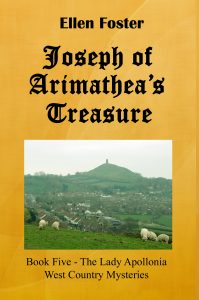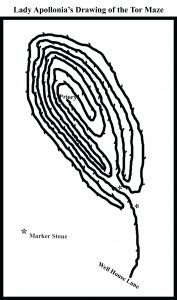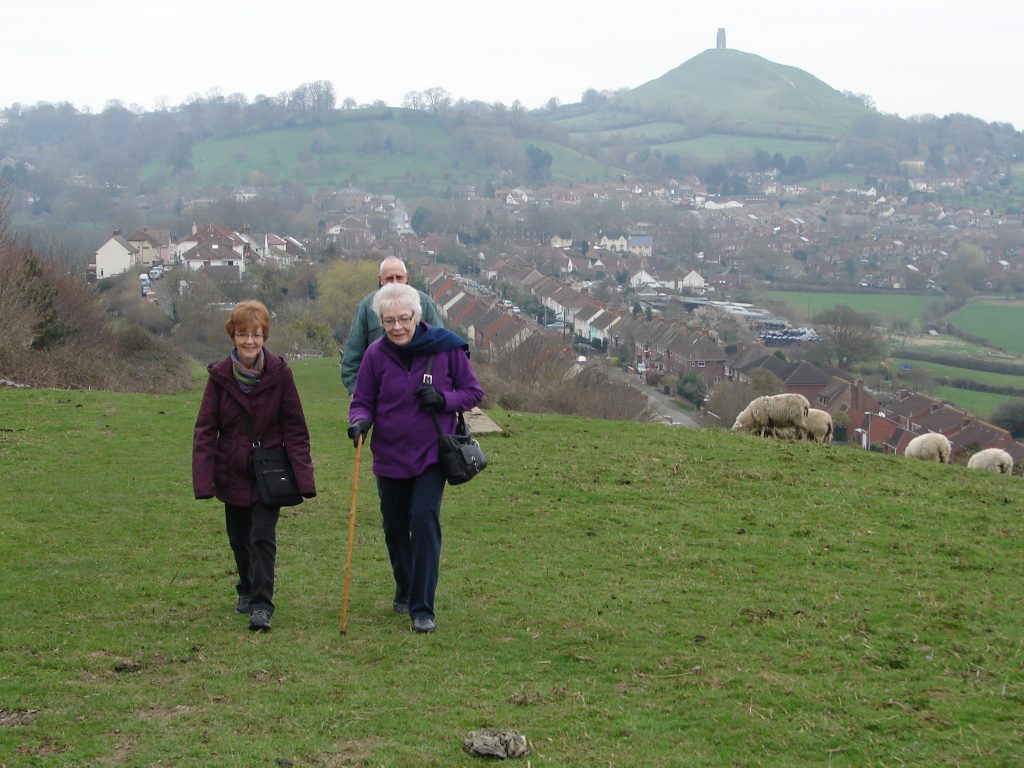 Glastonbury Tor dominates the skyline of Glastonbury, Somerset, the setting of Joseph of Arimathea’s Treasure, my fifth book in the Lady Apollonia West Country Mystery Series. The Tor, a Celtic word having nothing to do with the medieval tower at the top, is shown on the cover of the paperback version of my novel.
Glastonbury Tor dominates the skyline of Glastonbury, Somerset, the setting of Joseph of Arimathea’s Treasure, my fifth book in the Lady Apollonia West Country Mystery Series. The Tor, a Celtic word having nothing to do with the medieval tower at the top, is shown on the cover of the paperback version of my novel.
I first became aware of this startling feature of the landscape while traveling through Somerset on my way from Devon to Wiltshire from which my paternal Aust grandparents had emigrated to America in the late 19th century. As the highway took us across the Somerset levels, we had a preview of Glastonbury Tor as the road approached a smaller version of the hill called the Burrow Mump. Burrow and mump each mean hill and this hill had once served as a Norman motte and now has the ruins of a medieval church on top. The hill is, indeed, a miniature of Glastonbury Tor which, in just a few miles, began to appear, looming more than 500 feet over its surroundings with a church tower on its top, a sight I will never forget.
The next year, I was able to visit Glastonbury itself and climb the Tor, as shown in the picture below. My climb not only provided a wonderful view of the Somerset Levels below but also gave me some insight into the terraces which seem to texture the slopes of the Tor. These terraces are something of a mystery. Perhaps they made a labyrinth as some claim? Some of the terraces were possibly used for growing crops. One’s questions go on and on, but we do not know how or when such features of the Tor were made or what they represent.
One thing I did not see on that first visit to the Tor were any of the Tor Burrs or “eggstones” which are found on the slopes. These egg-shaped boulders are much harder than the sandstone which underlies the Tor and can be any size from an inch to several feet in diameter. Tor Burrs were of interest to some Druids in my story and I will speak of them in a future posting.
The terraces, on the other hand, were of interest to my heroine, the Lady Apollonia, while she lived in Somerset. She was fascinated with the labyrinth theory of which she learned and her attempt to sketch the labyrinth appears in my book as shown on the right.
An important feature of Glastonbury Tor in medieval times was the Priory of Saint Michael at its very top. The priory was a daughter house of Glastonbury Abbey and was dissolved along with the abbey by King Henry VIII in the 16th century. Only the tower of the priory church survives and sits atop the Tor, as shown in the background of the picture at the end of this posting. In the foreground of the picture, I am walking on a nearby hill with two of my English cousins and you can see the Tor in the background.
 Glastonbury Tor has been a place of mythology and spiritual interest to various peoples since truly ancient times. In my posting of May 10, 2021, I mentioned a Lake Village just northwest of Glastonbury which existed centuries before the Roman period. The inhabitants of that village were aware that Glastonbury Tor marked the southernmost sunrise of the year, important as the Winter Solstice. The Celts had spiritual interest in the Tor which is why I brought Druids into my story. Medieval mythology about King Arthur, mentioned in several of my recent posts, often named the Tor as the Isle of Avalon associated with the legends of Arthur.
Glastonbury Tor has been a place of mythology and spiritual interest to various peoples since truly ancient times. In my posting of May 10, 2021, I mentioned a Lake Village just northwest of Glastonbury which existed centuries before the Roman period. The inhabitants of that village were aware that Glastonbury Tor marked the southernmost sunrise of the year, important as the Winter Solstice. The Celts had spiritual interest in the Tor which is why I brought Druids into my story. Medieval mythology about King Arthur, mentioned in several of my recent posts, often named the Tor as the Isle of Avalon associated with the legends of Arthur.
Please join us next time when I will explain my choice of two Druid characters whom I include in Joseph of Arimathea’s Treasure.

